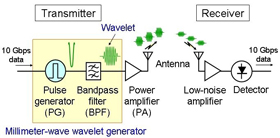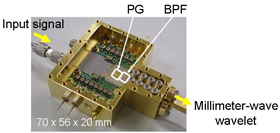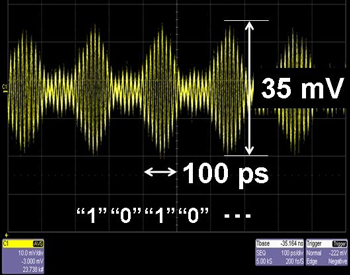
| Home | About Us | Contribute | Bookstore | Advertising | Subscribe for Free NOW! |
| News Archive | Features | Events | Recruitment | Directory |
| FREE subscription |
| Subscribe for free to receive each issue of Semiconductor Today magazine and weekly news brief. |
News
20 June 2008
Fujitsu develops first impulse radio transmitting at over 10Gb/s in millimeter band
At this week’s 2008 IEEE MTT-S International Microwave Symposium (IMS 2008) in Atlanta, GA, USA, Tokyo-based Fujitsu Ltd said that it has developed the first transmitter operating in the 70-100GHz band using impulse radio that is capable of transmitting data at speeds of more than 10Gb/s.
Impulse radio emits a pulsed signal that varies over an extremely short period and uses a filter to extract only the portion of the band needed for transmission. This new development eliminates the need for oscillators and other hardware that had been required for the use of earlier millimeter-band transmitters, reducing their size. Fujitsu says that, as a substitute for fiber-optic high-speed lines, the new transmitter could be used in a wide range of applications geared to help bridge the ‘digital divide’ (between those with and without the Internet), including platform networks and short-range wireless local-area networks (WLANs).

Figure 1: Impulse wireless transmission system.
The research was carried out as part of the ‘Research and Development Project for Expansion of Radio Spectrum Resources’, sponsored by Japan’s Ministry of Internal Affairs and Communications.
With the rapid expansion in mobile phone and Internet users, along with mounting data transmission volumes associated with video and other media, fiber-optic cabling has been used as the medium of choice for trunk-line data networks. But laying such fiber can be difficult when it needs to cross rivers or straits, mountains, roads or train tracks, stalling network build-out, says Fujitsu.
In these less accessible areas, this has created demand for a wireless alternative to fiber-optic cabling that would offer high transmission speeds (10Gb/s). A high-capacity wireless medium is also becoming increasingly necessary in times of emergency, such as natural disasters or other incidents, notes the firm.
Wireless transmissions with speeds exceeding 10Gb/s are practical using millimeter-band (30-300GHz) frequencies, which are seldom used commercially and where wide swaths of bandwidth can be readily secured. Within that band, the ‘radio window’ of 70-100GHz is attractive because signals are relatively unaffected by passage through the atmosphere, allowing them to travel several kilometers or more.
Transmitting in the 70-100GHz band, however, has involved multiple single-purpose electronic components, with little progress on miniaturization. This has therefore sparked interest in the development of impulse-radio technology, needing no oscillator, and the transmitter (millimeter-band pulse transmitter) can be constructed using only two components: an impulse emitter and an amplifier. However, 70-100GHz wireless communications required breakthroughs in generating high-energy pulse signals and the development of filters with low energy losses, says Fujitsu.
To implement millimeter-band transmissions at rates of more than 10Gb/s, Fujitsu and Fujitsu Laboratories developed two key technologies.
To obtain sufficiently high-energy pulses in the 70-100GHz band (especially up to 100GHz), the pulses need to be very short. The smaller the full-width at half-maximum (FWHM) for a pulse, the higher the energy it carries up to a high frequency; effectively, this requires a FWHM below 10ps. Fujitsu Laboratories therefore developed high-speed indium phosphide high-electron-mobility transistor (InP HEMT), resulting in what it claims is the world’s highest-performance ultra-short pulse generator. This is based on digital technology with a FWHM of 7.6ps (which has been proven to carry enough energy for frequencies above 100GHz).
The millimeter-band pulse transmitter carries energy in a short pulse across an extremely wide band, which must be able to extract only that band needed for transmission. Because the millimeter band is highly susceptible to losses caused by the skin effect, the researchers therefore also created a multi-stage coupled-line filter using an alumina substrate (which is readily obtainable and offers excellent high-frequency performance). The result is that the filter passes a signal frequency range of 78-93GHz, and losses within that range (insertion losses) were 1.5 +/- 0.1dB, resulting in the levels of performance needed for a millimeter-band impulse radio transmitter.

Figure 2: Newly developed millimeter band pulse transmitter.
The above two technologies were combined to create a millimeter-band pulse transmitter, resulting in the world’s first impulse radio transmitting at over 10Gb/s in the millimeter band (in this case, 78-93GHz). The new transmitter enables elimination of the oscillator, mixer and other components needed in previous millimeter-band transmitters, resulting in a compact package that is only about 30% the size of its predecessors.
Fujitsu Laboratories says that it plans to combine the transmitter with a receiver in order to conduct transmission testing with a fixed target. Field testing will be conducted, targeting development of practical-use systems by about 2012.

Figure 3: Results of actual measurements of 10Gbps-level pulse signals.
See related items:
Fujitsu’s GaN HEMT-based mobile WiMAX base-station chosen by UQ
Fujitsu launches GaN HEMT-based mobile WiMAX base-stations
Search: Fujitsu
Visit: www.fujitsu.com